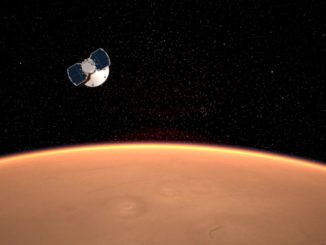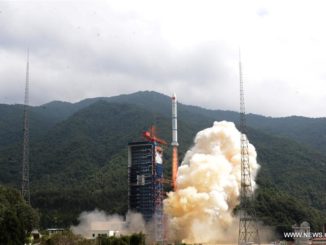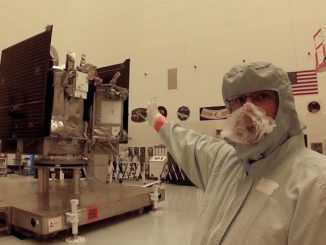
Two weeks into its mission of exploration on Mars, NASA’s Perseverance rover has completed its first test drive and returned some 7,000 images from its station in Jezero Crater, including mesmerizing vistas of distant outcrops from the first zoom-capable camera to reach the Red Planet, mission managers said Friday.
The rover is doing an “exceptional job” and with no notable faults or glitches, said Robert Hogg, Perseverance’s deputy mission manager at NASA’s Jet Propulsion Laboratory in California.
Other major tasks since the rover’s landing Feb. 18 included a software update to configure Perseverance’s computers for long-distance drives, instrument checkouts, and activation of the rover’s 7-foot-long (2.1-meter) robotic arm.
Perhaps the most significant milestone since landing occurred Thursday, when ground teams commanded the rover to drive forward, turn in place, and then back up. The first 33-minute test drive covered just 21 feet, or 6.5 meters,but Perseverance will soon travel much farther.
“Our first drive went incredibly well,” said Anais Zarifian, a Perseverance mobility test engineer at JPL.
Perseverance has six aluminum wheels, each with titanium spokes for support, and a suspension capable of traveling over rocks as big as the wheels themselves. The one-ton rover is based on the design of NASA’s Curiosity rover, which landed on Mars in 2012, but with some improvements.
The wheels on Perseverance are sightly narrower, have a larger diameter, and are made of thicker materials, Zarifian said. Engineers also changed the tread pattern on the wheels to reduce the risk of damage from sharp rocks, which created dings and cuts in Curiosity’s wheels.
A big change on Perseverance is the introduction of new autonomous driving software, which will allow the rover to navigate itself to a destination. Using images from its suite of cameras, the rover can autonomously steer around rocks and other obstacles, or stop the drive if conditions are unsafe. It currently takes more than 10 minutes for radio signals to travel from Earth to Mars, eliminating any chance for ground teams to send up real-time driving commands.
The software update on Perseverance’s primary and backup flight computers gives the spacecraft the smarts it needs for its surface mission, which is expected to last at least two Earth years, or one Martian year.
“The end result is kind of like getting an update to your electric car software,” Hogg said. “One day, your car knows how to do autonomous driving, detecting obstacles and navigating by itself, amongst many, many other bells and whistles that we have in store.”
“We still drive at 0.01 mph, same as Curiosity, but thanks to our improvements on our autonav software, our enhanced navigation software, and our new cameras, we can really drive about five times faster than Curiosity, and we’re capable averaging about 200 meters (660 feet) per sol (a Martian day),” Zarifian said.

“We’re able to think while driving,” she said. “So in other words, Perseverance can walk and chew gum at the same time. So we’re able to take a stereo pair of images, process those images on the VCE (Vision Compute Element), identify hazards in the terrain and choose a path forward, all while the wheels are still turning… So this means we can drive longer in the same amount of time, and we can have less time planning drives and driving on the surface, which means more time to do science.”
Controllers at JPL sent up commands for the test drive Thursday after checking the functionality of the rover’s wheel actuators, and putting the four corner wheels — which do the steering — through 30-degree range of motion tests.
With those tests successful, the rover “perfectly” executed commands to drive about 13 feet (4.5 meters) forward, turn 150 degrees to the left, then back up about 8 feet (2.5 meters). During the drive, the rover took pictures to image the points on the wheels where the rover landed last month. Perseverance’s “sky crane” descent system lowered the rover from a rocket-powered jetpack to the Martian surface directly on its wheels.
NASA has named the landing site “Octavia E. Butler Landing” after the late science fiction writer.
A second drive was planned Friday, when Perseverance was expected to turn on its ground-penetrating radar to begin collecting data on geologic layers in the Martian crust, according to Katie Stack Morgan, Perseverance’s deputy project scientist at JPL.
“Looking ahead, we’re going to to do some longer drives,” Zarifian said. “This is really just the beginning.”
Perseverance landed in Jezero Crater, an equatorial basin carved out by a violent impact from an asteroid or comet. The crater was filled with water more than 3 billion years ago, and a river flowing into the lake deposited layers of sediment now evident as a dried-up delta.
The rover’s mission is to explore the site, probe its ancient habitability, and collect more than 30 samples of rock and soil for return to Earth by a future spacecraft. The Mars Sample Return mission, a joint project between NASA and the European Space Agency, is set for launch as soon as 2026, and could return Perseverance’s samples as early as 2031.

Hogg said the rover is working well. Perseverance’s instruments have all passed preliminary post-landing checkouts, and the rover’s weather station deployed and is already collecting meteorological data. Earlier this week, the robotic arm moved for the first time, demonstrating it can maneuver a 100-pound (45-kilogram) turret packed with scientific instruments and a drill that will core out the rock samples for return to Earth.
“We haven’t had any hardware issues,” Hogg said. “Everything has been working that we’ve been checking out. It’s actually been amazingly smooth in that respect. I’m going to knock on wood here.”
Ground teams at JPL are analyzing images from the rover to find a safe place to release the Ingenuity helicopter, a 4-pound (1.8-kilogram) rotorcraft that will attempt the first flight of an aircraft through the Martian atmosphere. The Mars helicopter is scheduled to separate from its mounting point on the rover’s belly and begin tests flights in the next few months.
“We’re still analyzing various areas to determine the best place to do that, and the right place to do its flight,” Hogg said.
The exact timing of the helicopter flight will depend on the location officials select.
Hogg said the rover’s Sample Caching System still has to undergo more activations and testing before Perseverance can begin collecting rock specimens. The caching system is one of the most complex mechanisms ever sent to another planet, with its own internal robotic arm, seals, and a spinning carousel holding multiple drill bits for rock sampling.
The first use of the drill to gather a rock sample is expected this summer, following the helicopter demo.
In the meantime, scientists are eagerly awaiting every new image beamed down by Perseverance. The rover’s zoom-capable mast camera has returned jaw-dropping views of distant rock outcrops at the edge of the ancient river delta.
“The imagery coming down with the cameras that we have on this rover — the 25 cameras — the resolution, the colors, and the spectra has just been amazing,” Hogg said. “We’ve never been able to see Mars in this way.”

According to Morgan, the rover planning team is plotting out potential routes for Perseverance to leave its landing site and head for the river delta more than a mile away.
“Before we can think about exploring the Jezero delta, we have to figure out how to get the rover there,” Morgan said. “The science team is working with engineers to determine the best path for the rover to drive to the delta.”
One possible route would take the rover to the north over flatter, safer terrain before turning to the northwest to the edge of the delta. Another option is to drive toward the south and then west, taking Perseverance closer to rugged outcrops that scientists believe are the eroded remnants of the once-larger delta.
All along the way, the rover will be collecting and storing rock core samples inside 43 hermetically-sealed tubes it carries on-board. Each of tubes is about the size of a small cigar.
Once on the delta, the rover will likely start placing the sample canisters on the ground for retrieval by a fetch rover on the Mars Sample Return mission, which will take the tubes to a rocket for launch back into space.
“We’re working with engineers now to determine which path is most efficient, and safest, and most scientifically interesting for the rover to explore, and then we’ll arrive there at the front of the delta,” Morgan said. “From there we’ll go and explore the delta, and eventually wind up at the mouth of the river that once entered Jezero, where we will likely deposit our very first sample depot.”
Email the author.
Follow Stephen Clark on Twitter: @StephenClark1.



